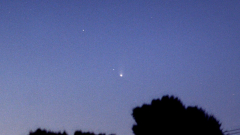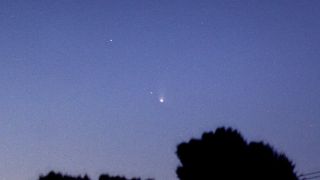
(Image credit: Michael Mattiazzo)
The saga of Comet Tsuchinshan-ATLAS (pronounced Choo-cheen-SHAHN -ATLAS), is now coming down the home stretch. When the Purple Mountain Observatory (Tsuchinshan) near Nanjing, China photographed a faint object in mid-January 2023, it was initially thought to be an asteroid.
Six weeks later on Feb. 23, the Asteroid Terrestrial-Impact Last Alert System (ATLAS) in South Africa photographed the same object, which determined it was actually a comet. At the time it was a very distant and inconspicuous object, but its orbital motion at once made it clear that by the fall of 2024, this comet could evolve into a naked-eye object of considerable interest for Northern Hemisphere observers.
But then, in early July, the highly reputable comet authority, Dr. Zdeněk Sekanina, published a paper that suggested that Tsuchinshan-ATLAS was disintegrating. Pointing to its lack of brightening en route to the sun from April through early July, and further citing that the comet’s tail was composed of larger-than-normal particles instead of dust, Dr. Sekanina declared that the comet was already in the advanced stages of fragmentation and inevitably would break into pieces too small to be seen from Earth.
Bright prospects for future visibility
However, as we are now past mid-September, we can say that the comet is not only alive but doing rather well.
From Aug. 12 until just a few days ago, the comet had been lost to most ground-based observers due to its proximity to the sun. But on Sept. 11, Australian comet observer Terry Lovejoy was able to photograph Tsuchinshan-ATLAS from Wellington Point, Queensland, Australia, while still deeply immersed in bright morning twilight.
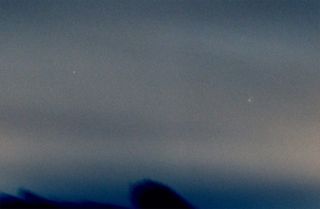
Since then, other amateur astronomers in Australia, as well as in Argentina, have sighted the comet, which is getting easier to see and to photograph as it emerges from the glare of the sun, and becomes a little higher in the dawn sky. On Sept. 15, Michael Mattiazzo from Swan Hill, Victoria, Australia, described the head of the comet as “strongly condensed” (a good sign!).
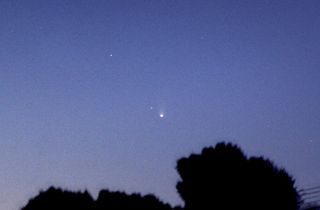
Another observer, Rob Kaufman, from Hay, New South Wales, Australia was able to get a good photograph that same morning, clearly showing both the comet head and two tails protruding straight up.
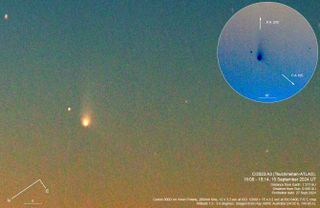
Estimates show that the comet had brightened up to about magnitude 4.6 — that’s about as bright as the faintest of the four stars in the bowl of the Little Dipper.
And it continues to ramp up in brightness.
Sun and done?
The final hurdle for Tsuchinshan-ATLAS to surmount will come on the afternoon of Sept. 27, when it arrives at perihelion — the closest point in its orbit to the sun. Contrary to what Dr. Sekanina had suggested back in early July, to date the comet’s nucleus looks to be healthy and intact and only one side is being exposed to the sun. A short-fused update based on the most recent observations being made from the Southern Hemisphere now suggest that Tsuchinshan-ATLAS will not break apart as it arrives at its late September rendezvous with the sun.
But there still remains a wide range of possibilities over what might happen just before, during, and after its brush with the sun. One drawback is we are probably dealing with an unusually small comet, whose nucleus only measures perhaps only about one-half to one mile (1 to 2 km) in diameter. Just before 2 p.m. EDT on Sept. 27, the comet will be racing through space at 105,000 miles (169,000 km) per hour and will be 35,952,000 miles (54,859,000 km) from our star’s visible surface (photosphere). That’s roughly the same as the mean distance of Mercury, the closest planet to the sun. Here temperatures can soar close to 800°F (427°C).
Consequently, as the comet — which for tens of millions of years, has resided in an environment where the temperature has hovered within only a few degrees of absolute zero, minus 459.67°F. — now is becoming increasingly exposed to the sun’s searing heat and tidal forces. As a consequence, its nucleus might still fracture at or before perihelion.
Picture hot tea being poured into a cold glass.
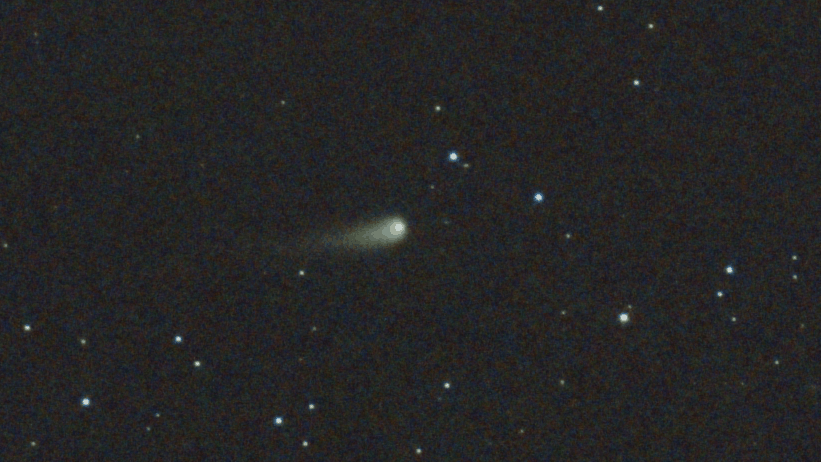
Comet returns for the Northern Hemisphere
So far, views of Tsuchinshan-ATLAS have been restricted to the Southern Hemisphere. That, however, will begin to change after Sept. 23, as the path of the comet begins to curve northward and brings it into view for Northern Hemisphere skywatchers, about 45 minutes before sunrise just above the horizon, about 10-degrees to the south of due east.
Remember that your clenched fist held at arm’s length measures roughly 10-degrees across; so roughly “one fist” to the right of due east is where you should concentrate on sighting the comet. Of course, make sure that you have a clear view of the eastern horizon, with no buildings or trees that might otherwise obstruct your visibility.
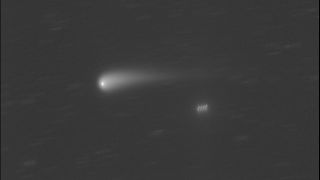
During the final week of September, the comet could shine as bright as second magnitude — about as bright as Polaris the North Star. Nonetheless, the sky background of the brightening dawn twilight could make the comet difficult to initiall

